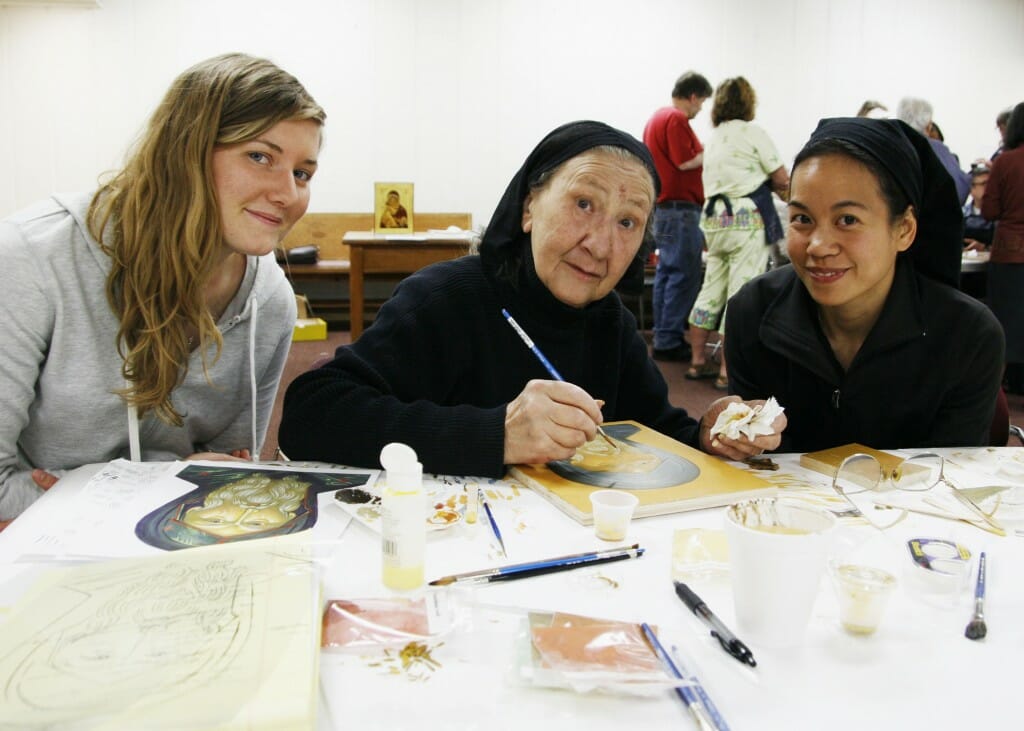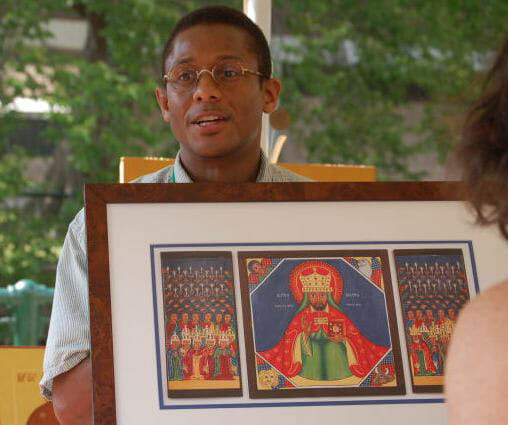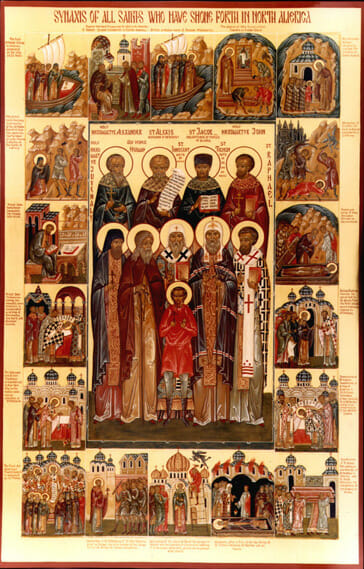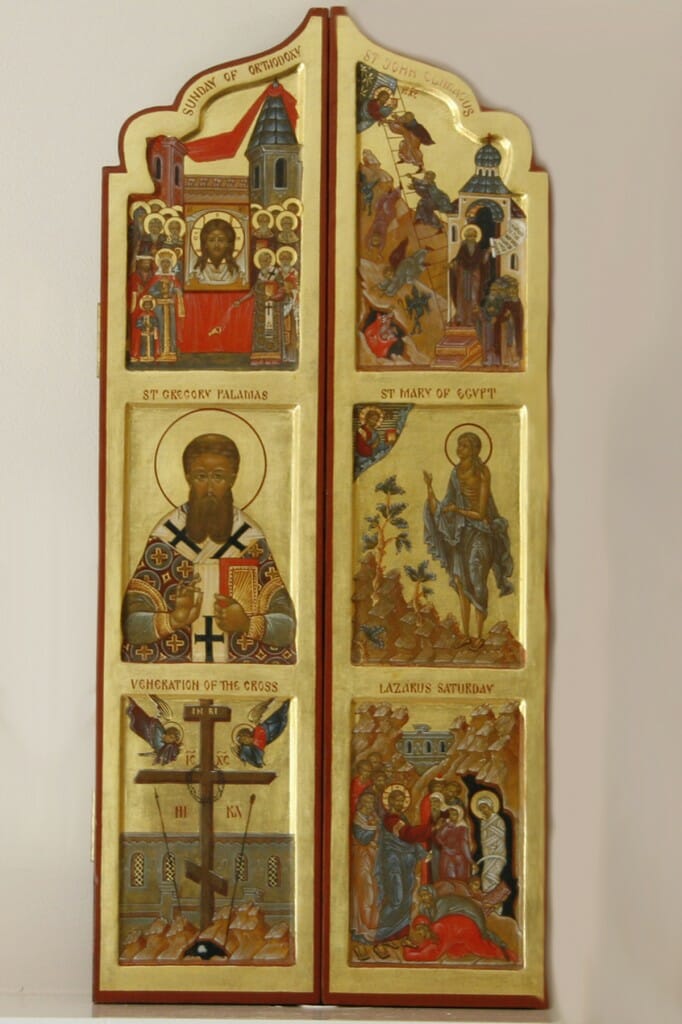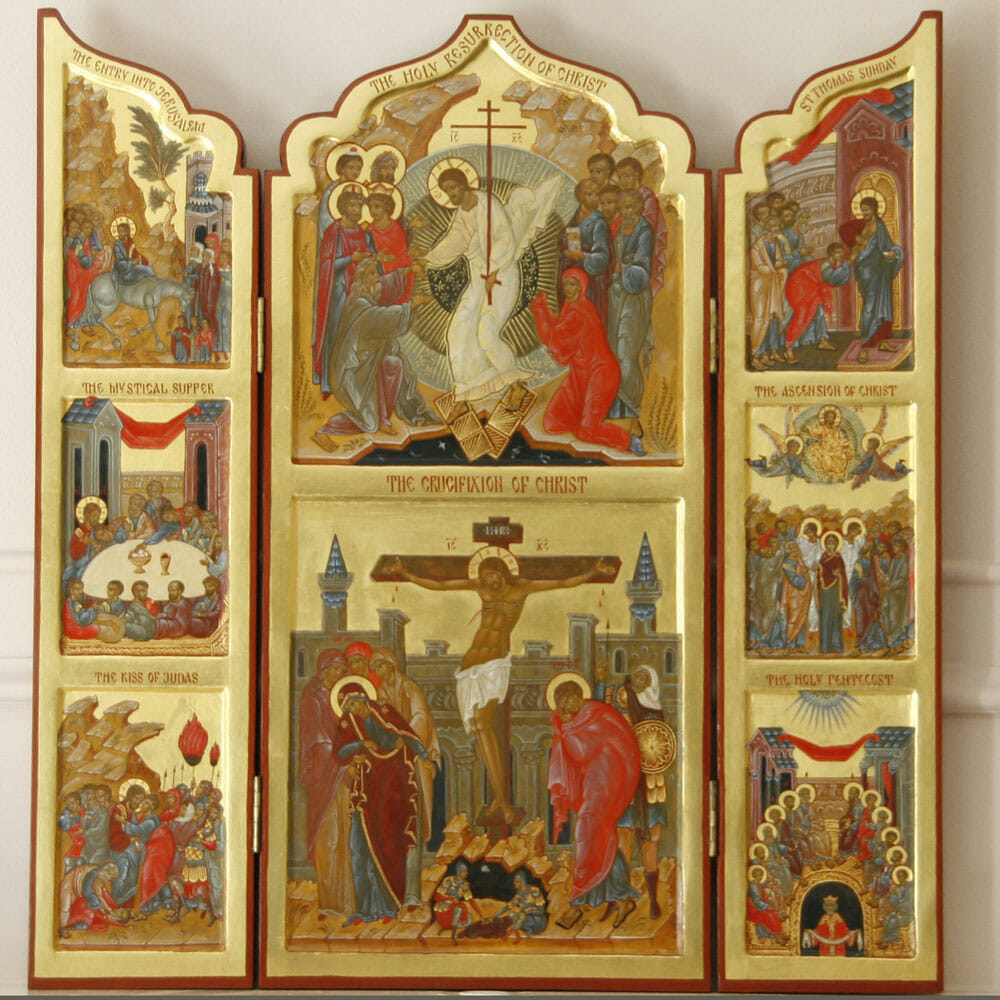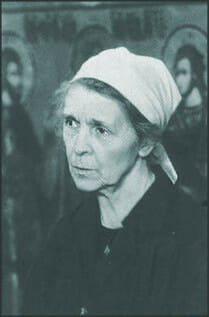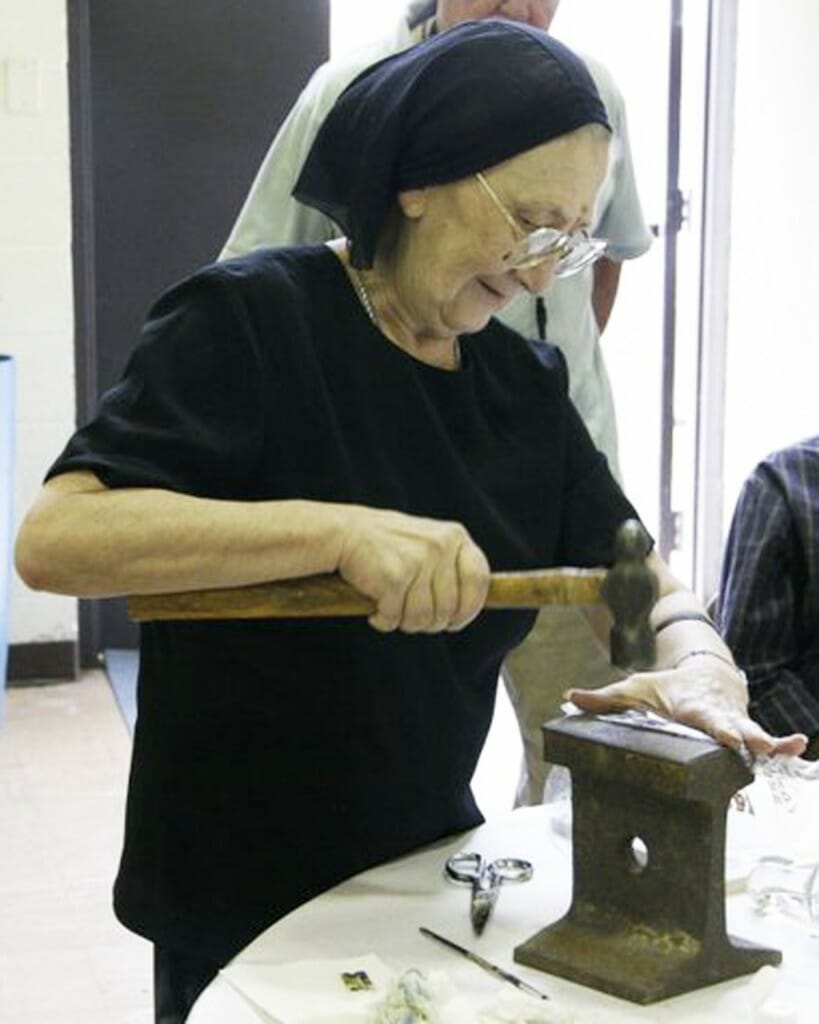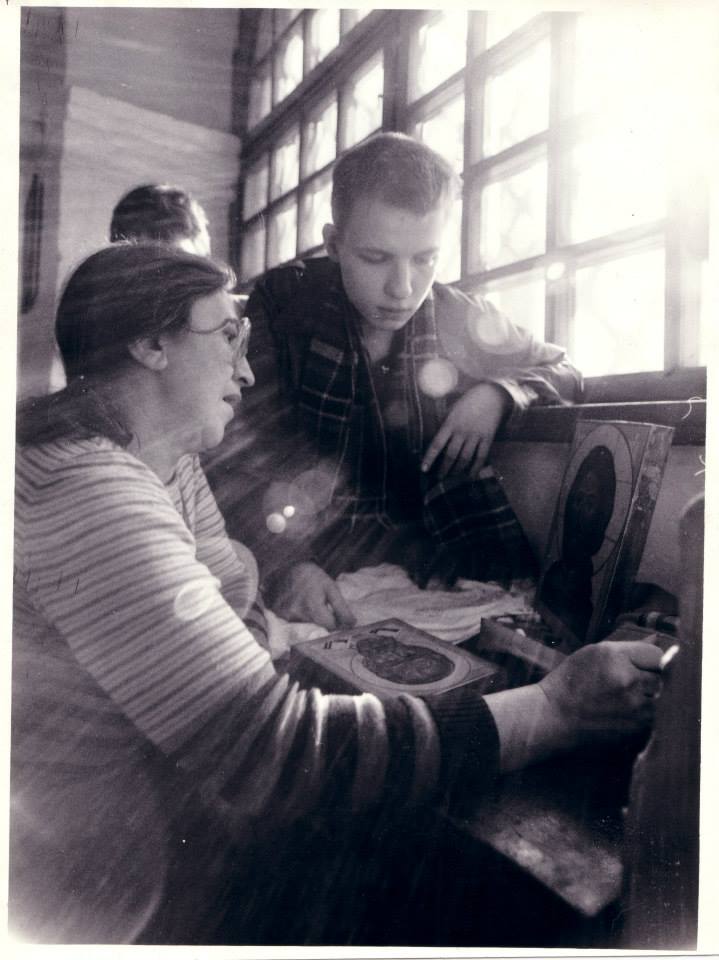Similar Posts
The life of Ksenia Pokrovsky (March 9, 1942-July 7, 2013) touched thousands of people from nearly every part of the world. Here are excerpts from an interview taken by Irina Yazikova in 2009 for an Italian magazine. Yazikova is a noted art historian and author of many books about iconography, including “Hidden and Triumphant: The Underground Struggle to Save Russian Iconography, in which she writes about Pokrovsky’s influence in Russia and her work in America. The entire interview in Russian can be found at http://www.art-sobor.ru/archives/5604
Mary Lowell
Excerpts from and Interview with Ksenia Pokrovsky
(Interview conducted by Irina Yazikova)
FOR ITALIAN MAGAZINE “NEW EUROPE” (2009)

Ksenia Pokrovsky and son Dmitriy (center) at the 1989 exhibition of the “Modern Icon” organized in the Znamensky Cathedral in Moscow. It was the first exhibition of contemporary church art held during the entire Soviet period. Prior to this exhibit, icons had only been exhibited as museum pieces and always as something from a period previous to 1917.
Irina: Ksenya, wasn’t it a crazy idea to leave Moscow at the time? To leave behind a well-established business, favorite students, customers? To leave Russia, a soil in which the icon is firmly rooted? Did it not seem to be utter madness to leave it all behind and move to the United States? Or did you have plans for America, expecting lucrative commissions and steady demand for your work?
What plans? We left not knowing where we were going, knowing nothing, understanding nothing, with no English, and above all, no clear idea what I’d be doing in the US. However, somehow it all has come about. In my first days in America, I wrote icons just for myself, only because I cannot cease working; it’s not in my nature.
So it happened that my confessor had already had a few of my icons. Then, he purchased some more. This was my first sale in America, which helped financially. After that, the priest commissioned even more icons. We could pay rent. In that first apartment, we didn’t have a studio; there weren’t any working conditions. I used a cardboard box for a table – just placed an icon board on it and worked. Thank God, I brought much with me – brushes, pigments etc. Soon I was able to exhibit my icons at a Christmas bazaar; they were sold, and I got a few commissions. These were my first commissions; more were to come.
Irina: And how did the first students find you?
Oh, this was a funny story. The owner of the booth that was selling my icons posted some publicity about me. A while later, a young Italian woman from Verona comes to me and says, “Hello! I will be your student.” I replied, “How could I possibly teach you? I barely speak any English.” (Truly, my English was non-existent then). “Even more so, Italian…” But she said, “In this case, I will be teaching you English, and you’ll be teaching me Russian.” I agreed. I asked her then, “What made you want to learn iconography?” And she told me her rather mystical story. Her husband was engaged in scientific research and was assigned to Boston University. Before leaving Italy, they went to see their confessor, Padre Bartholomeo. (By the way, he had shared a monastic cell at some point with the famous Padre Pio; he is very old now). Padre Bartholomeo blessed them for their journey to Boston. But then, Adriana asked him what she might be doing there, he replied, “You’re going to learn the Orthodox iconography.” She was confused, “But to do that, one ought to go to Russia!” And the priest said, “No, you have to go where your husband goes.” Adriana just laughed. But when she arrived in America, she came across my flyer, and she realized that Fr. Bartolomeo had been absolutely right. She was no longer in doubt that she must learn to paint icons. Turned out, Adriana had an aptitude for iconography. Her studies lasted a few years, and then she and her husband went back to Italy. They have four children now. Adriana still continues to paint icons. And she paints well! We are in touch to this day.
Irina: Adriana, as I understand it, was a Roman Catholic? Do you have many Roman Catholic students?
Quite a few, no less than the Orthodox. For example, one of my students is a Franciscan monk, a very learned and cultured man. He is a specialist in Stéphane Mallarmé, earned his doctorate at the Sorbonne. He is an outstanding iconographer. There are also Protestants among my students. In America, there is great interest in the Orthodox icon across many confessions.
Irina: Are your students mostly from the Boston area or do you also have visiting students from afar?
Oh, the geography of my students is extensive; they are coming from everywhere. And how they find out about me, I don’t even know. For example, one of my pupil lives in the mountains of New Mexico, where she has a huge farm with goats, chickens, and so on. In the courtyard she even has an owl and snakes, imagine. Twice a year, she leaves her farm and comes to me to study iconography, staying with us for two or three weeks. Her name is Claudia Gus, but we invented a Russian name for her – Klavdia Guseva. She writes icons beautifully!
Irina: Is she of Russian heritage?
No, she is a pure-bred American.
Irina: But she is Orthodox, isn’t she?
Yes, she is.
Irina: And how did she learn about Orthodoxy?
When she was still at school in Los Angeles, she had a Russian teacher. And one day he took his entire class to show them what a Russian Orthodox church looks like. There, she says, she encountered Christ for the first time. Soon she was baptized into the Orthodox faith. In New Mexico, they now have an Orthodox mission. When a visiting priest comes to serve liturgy, people from all over, from all the surrounding farms come to worship, no less than three hundred.
Irina: Wow, these students of yours are quite exotic characters.
No, Claudia is not so exotic. I’ve got another student, so that’s really a wonder of wonders! He is African-American, a very talented guy, Christopher Gosey. He writes in an original manner – Ethiopian! Very original, very vibrant. A few years ago he came to me and said he wanted to study iconography. At that time, he was working full time as a clerk. I agreed to give him lessons, but also told him that the subject of iconography is serious, and that one cannot engage in it as if it were a casual hobby. Later, he himself realized that, quit his job, and became a full-time iconographer. And an excellent iconographer! When I saw the way he worked, I told him, “Don’t change who you are; don’t shape yourself into an imitator of Greek or Russian iconography. You have to write the way your heart guides you.” And he now writes the way the ancient Ethiopians and the Copts wrote – very vividly, very decoratively, very expressively.
Irina: What church does he go to?
He is an Ethiopian Orthodox Church. In America, this church is quite numerous.
Irina: And so, among your students there are the Eastern Orthodox, the Roman Catholics, the Protestants, and on top of it — the non-Chalcedonians (the Miaphysites, to be precise in respect to the Ethiopians). Does it ever happen that enamored with iconography, people of other confessions turn to Orthodoxy?
It happens. You might think it strange, but the Roman Catholics rarely convert to Orthodoxy; they only go deeper into their own tradition. The icon allows them to move closer to the origins of the undivided Church of the first millennium. Icons are near to their heart, and icons also speak their language. Devout, serious Catholics love the Byzantine iconography more than what is nowadays common among them – sentimental realism painting. But turning to Orthodoxy is more common among the Protestants. It often happens that first they are introduced to icons, and then encounter the patristic theology, and quite often after that they convert to Orthodoxy. This is how they, shall I say, discover the Apostolic Tradition and get to know the Church in all its fullness. One of my former pupils, who converted to Orthodoxy from Protestantism, has become a close friend and almost a member of our family. She came from a very traditional Protestant background, but when she became Orthodox, there were some family ties broken, and she experienced rejection and the unwillingness to understand by her own people. Such cases in America are countless. Most of the Orthodox churches in America are now filled with converts from different Protestant denominations. Although, of course, for the majority of Americans, the Orthodox Church still remains an exotic entity.
Irina: Ksenya, you have lived in America for the last ten years. Is there an emergence of interest towards traditional iconography in America?
There is definitely an interest, and it is on the rise. But there are quite a few who take advantage of this and profiteer from it. There are teachers who barely know anything about iconography and its technique but for a hefty fee will to teach anyone how to become an iconographer within a couple of weeks. There are many who take the bait. They come from all across America, responding to a massive advertising machine. And after a two-week course, students firmly believe that they have become masters. They paint icons and even sell them. This, of course, is terrible. You cannot teach iconography this way. Iconography is only the tip of a huge iceberg that is known as Orthodox Tradition. You’ve got to know not only the technical methods but also the Church’s theology and its liturgy, and also to live a life of prayer. But they exploit it instead.
Irina: But I think this is the norm: the demand creates the supply. There are plenty of such swindlers in Russia now as well. But there are other examples, more positive, aren’t there?
Of course, there are positive examples. For instance, we have now a movable exhibit of modern American iconographers, for three years already. I have taken part in its formation and selection of works. We have gathered fifteen artists who exhibit hundreds of icons. This exhibition has already visited more than a dozen cities in the US, with great success. And in every city we have lines forming to get in.
Irina: One might say, the icon is making its way in America.
Yes, to a certain extent, this is true. This is something the Americans haven’t seen before; after all, their culture is still young – only about 200 years. In America there have been no Middle Ages, there have been no deep-rooted traditions like in Russia or Europe. Therefore iconography, even the new iconography carries in itself the memory of this centuries-old tradition.
Irina: What is most important for you in iconography? As an artist, you cannot stand still, only repeating what has been invented and coined before?
Yes, of course. Iconography is a traditional and canonic art, but it is by no means a mindless copying. Creative impulse in iconography must be very strong. For example, let’s consider the new iconography. Today, we must not be afraid of develop new prototypes and new compositions. We must not be afraid of doing something that has not been done before.
Irina: You have just such a composition, of course, is the icon of “All Saints who have shone forth in North America.”
Yes, I’m the first one to gather in one icon all the Orthodox saints who labored in America and preached Orthodoxy here. But I mean not only new composition. We should not be afraid of exploring new forms. I, for example, am very fond of the foldable icons. It has tremendous possibilities. For example, I am now working on a poly-typtic on the subject of Great Lent; there will be shown all of the feasts and the saints that mark and comprise the seven weeks of Great Lent. I have not seen such a composition before, anywhere.
Or for example, the triptych “The Creation-Salvation”. Here the theme of redemption is developed from the Creation, the Fall and the expulsion from Eden all the way to the Annunciation, the Nativity and the Resurrection. In this multi-part form, you can do a lot, and also find an interesting theological interpretation. The icon must speak to the mind and heart, to help in prayer, but has also to bring new understanding of the Good News.
Irina: And how did you come to the Church? Why did you take up iconography? You were born in the Soviet Union, a place and time alien to spirituality.
My coming to faith began with the DNA molecule.
Irina: How so? Please explain!
I was about 15 years old when I first saw in the magazine a drawing of the DNA molecule bearing the record of the genetic code. It impressed me so much that I ran to my grandmother, and began showing her the picture. And suddenly she was saying such strange words, “Yes, yes, it is the Covenant of Life. The laws of nature are the Covenant to Creation. The Law of Moses is the testament to consciousness. The New Testament is the testament to Salvation. And here – the DNA – is the Covenant of Life. This is the text, the word. So it should be. ”
Irina: That’s really true, “in the beginning was the Word.”
Well, yes, it is the Word, written in the human genes. Moses brought the Tablets, the Savior brought the Gospel, the laws of nature are written into the very fabric of the Universe, and the Word about mankind is written in mankind itself. The scientist Nikolai Vavilov, in his defense of genetics, was not quite sure himself what exactly he was defending. And those who persecuted him and put a ban on genetics in the Soviet Union sensed that genetics was something dangerous to them, that it wasn’t just some ordinary science.
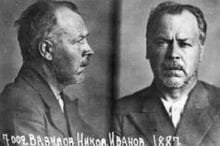
Mug shot of Nikolai Ivanovich Vavilov (1887 –1943) taken at his arrest in 1940. Vavilov was a prominent Russian botanist and geneticist known for having identified the centres of origin of cultivated plants.
It was not by chance that they banned it with such vehement viciousness. They fought God himself in the guise of genetics. When I realized what DNA was, I was stunned. This concept has stuck in my head, and I developed an interest towards this mystery, towards this miracle, towards the mystery of life. I finished high school and went on to study microbiology, to get closer to this mystery. But then the University’s biology department did not study genetics. And I realized that I need to come to biology through physics. I became involved in crystallography, biophysics and other matters. I studied the DNA code as well. I even discovered a hitherto unknown reaction, which made the topic of my doctoral dissertation. But at some point, I began to get a feeling that what I was doing was “dissection of the corpses”, that there wasn’t mystery in any of it. But where was the mystery? Here was a clear recognition of the need of faith.
Irina: Did you have a devout family?
It all depends how you look at it. One of my grandmothers was Bulgarian; she studied in Switzerland, was well-educated, was baptized in the Orthodox Church, but was not a practitioner. She just thought that faith is manifested in the way you live your life. On the other side of the family tree, I had an aunt – her name was Ekaterina (Catherine) – who was truly a church woman, Orthodox. She was the one who took me to church when I was little. And these two women have had a great influence on me; moreover, I did not see any contradiction in those two, but only two different points of view on the same subject. And so, when I gave up on science, it was only natural to me to find myself churched and take up iconography. There was some internal logic to it all.
Irina: Did you do any drawing before?
A little bit. My aunt Katya (Ekaterina) was an artist. And one time I was considering enrollment in the School of Architecture, even spent the whole year taking preparatory classes. This, of course, wasn’t at all enough to become an artist. But it is a good thing that I didn’t become a fine artist, because the most difficult thing is to have to retrain yourself. In order to become an iconographer, you need to forget everything you’ve been taught in art school, in college, because the essence of the artist is self-expression, which in iconography should not be in any case. I was lucky, I had almost had nothing to unlearn.
Irina: Who was your first teacher?
At first, I studied with my priest, Fr. Anatoly Volgin. However, he himself was a beginner – he had begun to write icons about six months before I did. We all were beginners. Basically, we copied reproductions, went to museums, tried to peer into the old icons. It was a quest, an attempt to figure out things. We also tried our hands in restoration of icons. This also gave us an understanding of technology – how an icon is made, how brush strokes were made, about various techniques etc. Then there was one summer, probably in 1974, when we rented a summer cottage near Maria Nikolaevna Sokolova, Mother Juliana. And I came to her with one of my icons. At first, her comments were negative – this is not right, that is not right… But then, she looked at it again and said, “You know, keep at it, keep working.” I cannot say that she was my teacher. I did not take part in her iconography studio at the St. Serguis Lavra; I only came to her occasionally for advice.
Irina: I know that you are very particular in your approach to the technical aspect of icon writing. For example, Maria Nikolaevna Sokolova wrote icons in egg tempera, in acrylic, in gouache, and in oil. Of course, those were hard times, nothing was readily available then.
Yes, it was difficult to get paint. But from the beginning I wanted to write “for real,” using natural pigments. I even had – as I call it – a “geological” period. I developed a passion for minerals. We, the young iconographers, were literally chasing the natural pigments and minerals day and night. I remember the first time I saw cinnabar, what a joy it was! We collected stones, brought them from all over the country, and pulverized them into pigments by hand with a glass mulier. Lapis lazuli, azurite, orpiment, you name it. No synthetic pigment could possibly compete with these natural pigments, no way! I have the whole collection of mineral pigments.
Irina: And you took this small fortune with you to America?
Certainly, how could I abandon it? And this collection has only grown bigger. You can get anything in America, any pigment. Albeit, for an icon, in general, one does not need much – just three or four basic colors, not counting black, white, and gold.
Irina: What about your first students in Russia? How did they find you?
Absolutely spontaneously! Someone asked me to show him how to write faces; someone brought his or her work to show; someone just started working by my side. None of us old-timers considered themselves master iconographers; it was just one big circle of colleagues and friends. Gradually, we worked out the methodology of teaching. However, I must say that this particular teaching methodology – which I use – came from Fr. Anatoly Volgin. This is the most effective teaching method.
Irina: And what is this method?
First, we learn how to write an icon that has only the head and the shoulders. This allows us to concentrate on the face and the hair. The next step is to learn how to write half-figures, from the waist up. Here we learn how to write garments, folds, how to do the lighting. Now, at this stage we have an interesting complication of the task: the face becomes smaller but it has to retain the same elements that we would have in a large-size face! Once that stage is mastered, we proceed to full-size figures. The same technique as before, only now we have a better understanding what goes where. At this stage it is unlikely that one would push the eye into the ear – which typically happens when you start learning the craft by making a small icon. After those three stages, we proceed to a composition that has either buildings or mountains in the background, but not both. At this stage the new thing for the student to learn is the buildings and the mountains – everything else is already familiar to the student. And all subsequent work is from simple to complex, from the Annunciation to “In Thee is Gladness”.
Irina: With this method you use to this day?
Yes, it is time-tested.
Irina: How do you assess the level of iconography in today’s Russia?
In general, I believe that the overall level has improved markedly over the past ten years. It is a pity that there are not that many new names. Those who are active today are the same people that began at the same time as we did or a bit later, around 70s or 80s. These are Fr. Zinon, Alexander Lavdansky, A. Sokolov. They are well known outside of Russia and are sought after abroad. In everything else I feel there is a lot of commercialism and not enough artistry. But maybe it’s only growing pains.
Irina: Thank you very much for the interview. I wish you success in your work. May you have many new students! And may the seeds of iconographic tradition you plant in the American soil germinate a new iconographic tradition for this country. God willing, the icon will become a revelation and a “contemplation in color” as it was one for Russia.

